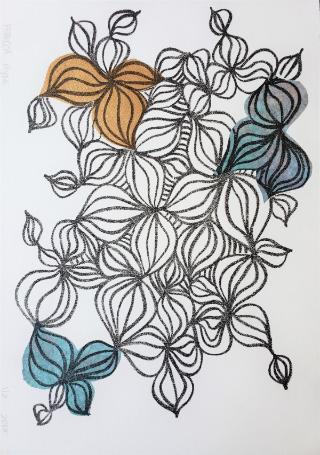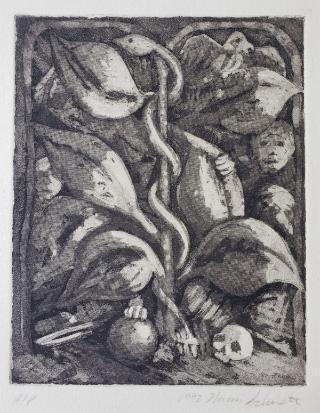The process of lithography was popularized by Bavarian actor Alois Senelfeder in 1796 to easily distribute published works such as screenplays and flyers. Originally produced on lithographic limestone, modern and more affordable options have been developed through the use of ball ground plates and photo-lithography to replicate the process.
Lithography relies on the opposing forces of water and grease. A grease or oil-based product is used on the stone onto the matrix. A drawing material made of grease is used to create the image on a plate or stone. After the water has been applied to the plate, a roller is used to adhere oil-based ink to the marks where grease has been placed. The rhythm of applying an even coat of water and rolling the ink onto the plate is essential to the process of learning lithography. The unique quality of lithography is the way the drawing materials provide the artist with a range of textures, creating a variety of marks that can be made on one single plate. The use of textures creates a symphony of tonalities in mono color and can be printed to include several different colors.
In this course, students have the opportunity to learn the various techniques of lithography including ball ground plates, photo-lithography, and stone. Students have the opportunity to layer multiple layers of images to create depths of color, as well as exploring compositional techniques including collage and bookbinding.
The origins of woodblock printing are as old as time itself. As early as 220 AD, woodblock prints were used for pattern making and textile work in China. Woodblock became widespread in Japan for its Edo style by using multi-colored prints. Woodblock prints reached their height during this time and are still cherished for their quality.
Woodblock printing, as presumed from its namesake, requires wood as the matrix for the image. The artist cuts into the wood to create a relief print. Ink or paints are applied to the protruding wood using a brayer or paintbrush. Unlike other forms of printmaking, woodblock requires a dialogue between the wood and the artist. The course begins with learning how to make a reduction print. As an entry into woodblock printing, the reduction print helps the students practice conversing with the wood through carving. They are introduced to various carving tools including gouges, knives, and other shaped tools. Then students examine more complicated pieces in a study of the Edo style. Students expand on a composition involving the placement of multiple components including layers, colors, or materials such as Nori (rice paste).
Students experiment with larger projects using different kinds of wood, colors, and medium. Like other types of printmaking, the artist must work with the material of the matrix. The artist must learn to adapt to the character of the wood because it is cut from a living and breathing organism. Navigating the knots and grain allows the wood to be a collaborative element in creating the artist’s composition. This course is a meditative experience with nature.
This course is deeply rooted in understanding the traditional techniques of intaglio. The technique of intaglio entails creating an image on a plate through incised lines or sunken areas. The ink is received in the depressed areas of the plate and runs through the press. This process is explored through dry-point etching, aquatint, and sugar lift. The course introduces this process by learning how to carve into Plexiglas. The artist learns how the depth of line making and engraving alters the reception of ink. Once the carving is complete, artists learn how to spread the ink until it is evenly distributed throughout the entire plate.
From Plexiglas, further exploration is provided through copper plates and applying chemicals. With the application of chemicals and blocking certain areas, peaks, and valleys are created in the copper plate. Developing these regions of depth in the copper plate creates a range of tonalities and textures to the image. The process of intaglio is an intimate experience between the artist and the plate because of the vast freedom of experimentation that can be developed on the plate. The capacity of experimentation and how the print can be altered on the plate is highly encouraged in this course.
Silkscreen (or also known as screenprinting) is a printing method that requires ink to be pushed through a screen made of tightly stretched fabric on a metal frame. This course explores a variety of techniques to block areas of the screen to transmit an image on a surface, starting with creating a stencil on contact paper. The contact paper is adhered to the screen, allowing the ink to pass through the unblocked areas of the screen.
After becoming familiar with the screen through the use of stencils, the course continues on with learning two-color processes and photo emulsion. The emulsion provides the artist with the ability to experiment with more complex imagery and layered compositions. The use of photography, digital imagery, as well as painting and drawing on mylar are explored in this segment of the course.
Color is what truly brings out the joy of working with silkscreen. The distinctive pop of color is what separates silkscreen from other forms of printmaking. The artist learns how to manipulate and build colors, transcending the composition into a vibrant and graphic work of art. The vibrant nature of this medium makes silkscreen a very beloved course on campus by many.











